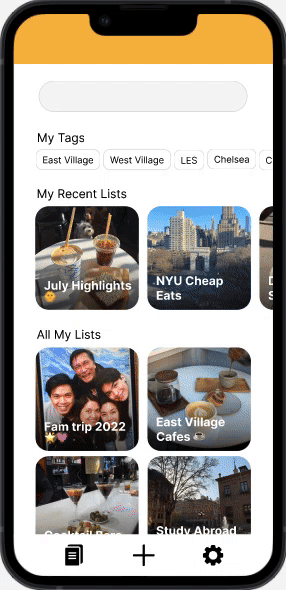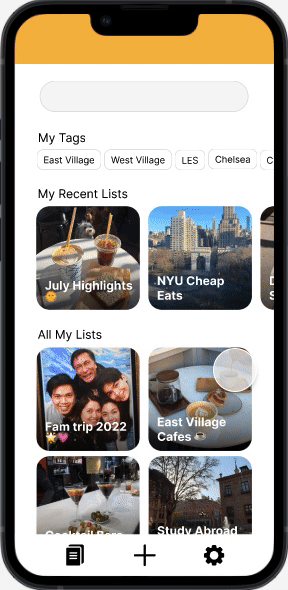Reco 🍽️
A personalized catalog of restaurant explorations and recommendations.
Background
Academic, Ideation & Prototyping class
Solo project
Tools
UX Design & Research
Figma
Duration
Ver 1 - Fall 2021
Ver 2 - 2 weeks in Fall 2022

Overview
Growing up traveling around Asia, food has always been a way for me to get to know a country, city, and its cultures. This motivated me to create a product that could help young adults like myself express their love for local restaurant scenes and feel encouraged to connect with communities and friends through food.
I began this as an academic project but revisited it as a passion project around graduation to reiterate with a matured perspective.
I wanted to challenge myself to explore ways a digital product can create meaningful IRL conversations and connections. Because of this, I set it as a constraint to not design a social network.
Problem
Twentysomethings in NYC struggle to keep track of their restaurant explorations.
Gen Zs and Millennials look to explore the NYC restaurant scene. Through these experiences, they generate their own insights on the local restaurant scene. However, they ask: what use is this information?
Design Challenge
How might we turn an individual’s restaurant explorations into valuable content?
Solution
Reco, your personal catalog of restaurant recommendations.
Create lists to organize your explorations.
Users create individual restaurant recommendations and file these under list(s) of their choice. An easy way to organize your thoughts and experiences!
Keep track of restaurants you’ve tried and take note of what you thought about them.
Reco guides users to turn their opinions into concrete tips and tricks, for their own personal future reference or to share with others.
A handy tool that lets you browse your tips & tricks at all times.
The homepage showcases all the lists a user has made for easy access. Users can click on a list, browse the restaurants they’ve included in it, and see notes they have on each restaurant.
Initial Market Research
Millennials and Gen Z want to spend on eating out.
Research shows that both millennials and Gen Z favor food-away-from home and a considerable portion of their income is spent on eating out. And apparently, it would take 22.7 years of eating at a new spot once a day to hit every restaurant in NYC. Talk about options!
This data helped me narrow down my target demographic to twentysomethings living/working/studying in NYC.
User Research
My interviews revealed 3 areas of excitement when exploring the NYC restaurant scene.
I interviewed 5 twentysomething individuals who frequently explore the NYC restaurant scene to understand their needs and frustrations. Interviews revealed 3 areas of excitement to look into:
☺️
Tracks their explorations
They keep track of restaurants they’ve been to and catalog their insights.
Insights typically include: comments on dishes, customer service, ambiance.
☺️
Like to pass on first-hand knowledge
They enjoy writing about + sharing their explorations with others.
They love feeling like an expert on where to eat!
☺️
Talks about NYC restaurants often
The NYC restaurant scene is a frequent conversation topic. They love to swap stories and share tips with friends and strangers alike.
… but also pain points they encounter when cataloging these explorations
😥
Reliant on memory
They generate insights about restaurants they’ve been to but can forget these over time.
😥
Disorganized
When they do write down their insights, these are inconsistently spread across Notes app, Google Maps, Yelp, Excel, social media.
😥
Lack of privacy
They don’t like the pressure of posting publicly, on review sites or social media.
Other times, they want hidden gems to stay hidden!
“I hate it when a friend asks for my thoughts on a restaurant, and I can’t remember details of my experience.”
“My notes are all over the place.”
“I want to gatekeep places for me and some friends.”
“I’m not a food blogger, so I don’t post every restaurant I’ve been to.”
Key Findings
Individuals catalog their restaurant explorations both for personal future reference and to share information with others
They frequently consult friends and acquaintances for restaurant suggestions + tips and tricks
They look to express their own love for the NYC restaurant scene
Opportunities
Translating pain points into design opportunities
🤔
How might we make it efficient for individuals to track their explorations?
🤔
How might we make it easier for individuals to organize their insights?
🤔
How might we offer individuals more control over their privacy?
Competitive Analysis
No one product does it all.
I wanted to figure out how individuals currently keep track of their restaurant explorations and insights.
I found that users employ a variety of applications to catalog. Synthesizing which functions they found most helpful, I realized that there were no channels specific to restaurant tracking.
Ideation
🌟 I set out to create an experience that empowers users turn their insights (aka, vague personal experiences and opinions) into recommendations (action-oriented, informed tips).
I explored applications that function to catalog and organize, like Goodreads, Letterboxd, Spotify. These helped me explore potential interfaces and map out flows that felt most natural.
User Testing
User testing lo-fi wireframes, I arrived at 3 actionable insights to translate into design decisions:
Actionable Insight #1
Users took time figuring out what insights to write down
How can I help users jog their brain for insights both they and their friends will find valuable?
Design Decision
While reiterating, I realized that users need guidance in figuring out what details to include in their restaurant entries.
Because of this, I decided to create short and optional writing prompts to guide user’s thinking.
When a user saves a new restaurant entry, they are encouraged to provide more details of their experience. A variation of prompts, from favorite dishes to comments on ambiance, will be offered.
Actionable Insight #2
Users organize differently
When creating recommendations, users made categorization schemes unique to them. Location (“East Village ramen”), cuisine (“Japanese food”), and personal moods (“Dinner for rainy days”) were common categories.
Design Decision
This made me realize that different people = different priorities.
Because of this, the organizational tools must be easily customizable and shouldn’t leave users feeling limited. I added optional category tags that give users the power to personalize their organization.
DECISION: Majority of users didn’t create too many tags (<10). Therefore, having them all displayed felt more accessible than having a drop-down or search.
Actionable Insight #3
Users said they would trust a friend’s recommendations on Reco
How can I leverage this trust but still give users control over their privacy?
Design Decision
Across the board, users valued privacy for their own lists but simultaneously wanted access to their friend’s lists.
Because of this conflict of interest, I propose that Reco could integrate with existing social media apps to encourage users to share their recommendations with their network.
The option to share, I decided, should come with control settings to meet varying privacy and connection needs.
Reflection
Reco got me excited to someday work on full-scale products requiring high collaboration.
I wore a lot of hats for this solo project but updating my peers and professor during weekly progress reports made me realize the power of collaboration in design work. I learned how to communicate clear goals, explain how I arrived at certain decisions, and be honest enough to ask for help when I needed it. This practice made me even more excited to someday be part of a design team!
… I’m still reiterating and looking to learn more :-)
Having more design practice behind me, I reiterated Reco as a senior with more strategic and intentional decisions. I was braver in exploring potential design decisions instead of imitating familiar designs I recognized on Instagram or Dribble.










